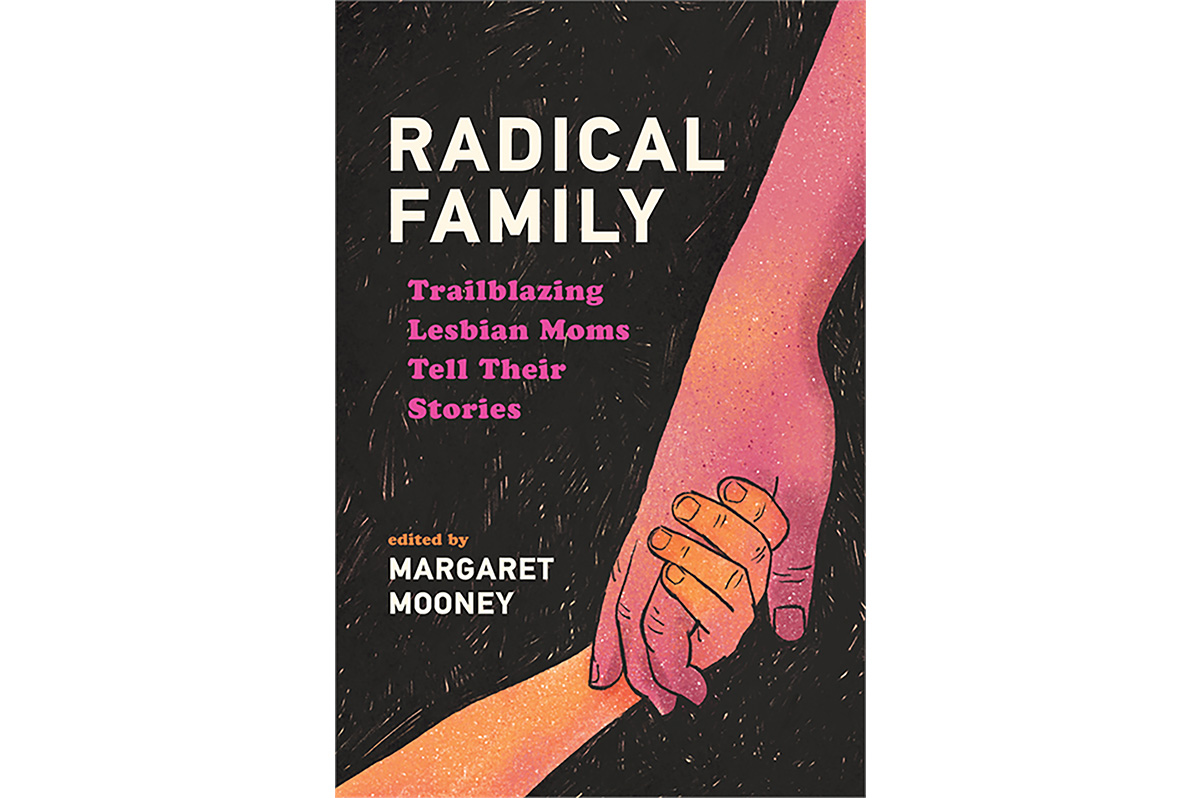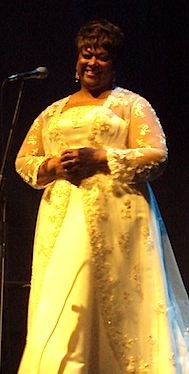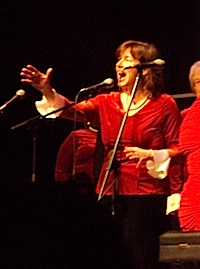Arts & Entertainment
MCC bids Hughes farewell
Gay church choir joined by GMCW; Chaka Khan and Meshell Ndegeocello also had recent D.C. appearances

Metropolitan Community Church of Washington (MCC-D.C.) pulled out all the stops for its Christmas concert this year but even with another diva in the house — guest singer Oleta Adams — it was still Shirli Hughes’ night, as it should have been.
Hughes, the church’s minister of music (and a lesbian), has resigned and Saturday night’s concert was her swan song after a decade running the church’s music program. It felt as though she decided to go out with a bang — the concert was held at the Lincoln Theater (usually all MCC concerts are held at the church) and there were two big guests: Adams and a healthy fraction of the Gay Men’s Chorus of Washington which has its own holiday show the weekend of the 16th (go here for details).
That Adams sang beautifully was almost a given. She owned the stage during a three-song mini-set late in the second half during which she accompanied herself on electric piano with her hit “Get Here” and an exquisite cover of Amy Grant’s “Mary’s Song (Breath of Heaven)” that’s also on Adams’ Christmas album. Initially I thought she sounded too muscular for the tender lullaby but she settled into a moving rendition of the song marked by dead-on phrasing and vocal nuance.
And, of course, I know rehearsal time is often either highly limited or non-existent when you bring in a big-name artist, but it was almost tragic to hear the canned backing vocals on her opening number “Hark the Herald Angels Sing” considering the bounty of choral talent that was sitting back stage. Thankfully she joined them on closing song “Joy to the World” (mostly the Three Dog Night version but not entirely), which gave the concert a less compartmentalized feel among its participants which, prior to that, had been totally insular (the MCC choir didn’t sing a note with the GMCW; they’re much different outfits, of course, but some sort of collaboration would have been refreshing).
The concert, playing to a packed house, was designed to give the church a chance to show off its abundance of talent. Several soloists — especially Marcia Newbill, Gbenimah Slopadoe, Jeffrey Herrell and Yartumo Gborkorquellie — have pro-caliber voices and could be on Broadway or in Los Angeles recording studios if they wished. Equally good, Natalie Carter’s warm, silky solo on “My Sweet Lawd” was understated yet powerful. And old MCC standbys Lisa Carrol, Tanya Harper and Michelle Lanchester (Hughes’ partner) were each in fine voice. Carrol, who possesses a lovely alto timbre, has excelled under Hughes’ guidance and has found new range in her interpretive abilities. And Lanchester, a soul growler who can ad lib with all the passion and fire of any big-name gospel act, sounded better than ever last night. She has, at times, been hampered by muddy acoustics and ill-tempered mics in the MCC sanctuary but last night the balance was perfect. There were some howling mics here and there, sadly, but they were mostly worked out by the time she came on.
Hughes opened the second half with two solos — “Ave Maria” and “O Holy Night,” both of which she’s performed previously at the church. The latter, especially, was lovely and allowed her to show off her interpretive finesse and range to their fullest. They also exemplified, by contrast, what makes Hughes such a rare talent — she can kick back and throw down with the most sanctifying gospel grooves but on her solo selections she proves she’s got great classical sensibilities as well and is undeniably a trained singer. It’s quite rare to find a musician, whether he or she is singing or directing (or accompanying as Hughes also does), who can pull off both extremes so successfully. Though mercurial at times — and she would likely admit to that — she leaves enormous shoes for the church to fill. Music can totally make or break a worship service.
The Gay Men’s Chorus sounded lovely as usual — their harmonies, tighter and more refined (but also more staid) than MCC’s — are undeniably great. Their overall pitch is as precise as a tuning fork. They continue to excel under Jeff Burhman’s sturdy leadership.
There was only one misstep of the evening but unfortunately, in my estimation anyway, it was a huge one — a medley of Hanukkah songs the GMCW closed its mini-set with. While musically they provided the show with a nice change of pace, thematically it was jarring and completely out of place. I’m all for diversity and respect of other faiths especially during the holidays, but MCC is a Christian church and this was a Christmas concert. A few secular songs that were included — a slightly wobbly “Christmas Song” by the church’s string ensemble and a medley of “I’ll Be Home for Christmas” and “Merry Christmas Darling” by the GMCW — were fine. And I’m not of the mindset, as are many Christians, that everything performed during a church program has to be explicitly religion in text. Yes, Jesus Christ was Jewish himself, but to include a selection of material that rejects the divinity of Christ at a Christian Christmas concert was offensive. I was probably in the minority on this point though — the number was as heartily applauded as any of the night. It’s a shame, though, as the GMCW has several gorgeous sacred Christmas numbers in its repertoire — much more appropriate would have been selections like the Bass “Gloria,” or the Mendelssohn “Say Where He is Born” or “There Shall a Star” they performed at their own concert last year.
But that’s quibbling — overall, it was a great, great night. Kudos to Adams for graciously singing autographs and posing for photos after the show.
I’ve been meaning to blog, too, about two other concerts I caught in recent weeks that are both of considerable queer appeal. Chaka Khan played a tight half jazz/half pop/funk concert during a two-night run at the Birchmere last week. I caught the first show Monday night. And bi bassist Meshell Ndegeocello was also at the Birchmere a couple weeks before (on Nov. 15) for her “Weather Tour,” supporting her brand new album. I interviewed both of them (here and here) prior to their appearances.
Khan’s was far tighter and more generous. Playing an hour-and-45-minute set, she opened with standards like “I’ll Be Around,” “To Sir With Love” and “My Funny Valentine” before putting her own stamp on a four-song set of Joni Mitchell covers, only one of which (“Ladies Man”) she’s recorded herself. The standouts were the moody — it’s perhaps the darkest song in Mitchell’s entire canon — “Two Grey Rooms” and a highly unusual take on “Man From Mars” that gave her kick-ass band time to solo and jam. You wouldn’t think they’d pick that kind of a song on which to solo — Mitchell’s version is slow and atmospheric — but somehow it worked.
Khan closed her show with several hits — “Everlasting Love,” “Tell Me Something Good” and “What Cha Gonna Do 4 Me” (but not “I’m Every Woman”). She gamely sang an a cappella verse and chorus of “Fool’s Paradise” at a request, and gave her testimony of getting clean during an emotional reading of “Through the Fire.” She was in dazzlingly fine voice — her extraordinary pipes are as bright and strong as they’ve ever sounded. Her voice is a feat of nature — she could blow Aretha Franklin, Whitney Houston and Gladys Knight away with a sneeze and I’m not exaggerating.
Meshell, conversely, is almost an anti-singer, an anti-entertainer. She’s much more a funky groove chef than a great singer. Her vocals are wispy and non-committal, but armed with her bass and a tight band, there were smoldering sonic stews being conjured throughout her hour-and-20-minute set. She also does exactly as she pleases. There were no hits (unless you count the one “Plantation Lullabies” song she performed, “Outside Your Door”) and 11 of the 17 songs she did are from the new album. I’m all for artistic license and unpredictability — you don’t go to a Meshell show expecting hits — but even that was, admittedly a bit self indulgent on her part. But she doesn’t care and that’s part of her charm. She did make some small talk and said she was enjoying herself — but she’s so laid back and “chill” it can be a bit polarizing. Nobody expects her to be Wayne Newton, of course, but I mean c’mon — isn’t there some middle ground she could stomach without feeling like a human juke box?
MCC’s set:
1. Andaluza (piano solo)
2. The Christmas Song (strings)
3. Gloria We Sing
4. Hallelujah
5. Amen
6. My Sweet Lawd
7. Emmanuel Medley
8. Jesus Brings Joy
9. Perfect Praise
10. Wonderful Child Medley
11. Ave Maria
12. O Holy Night
13. In the Bleak Midwinter (GMCW)
14. I’ll Be Home For Christmas/Merry Christmas Darling (GMCW)
15. Music of Hanukkah (GMCW)
16. Hark the Herald Angels Sing/Angels We Have Heard on High (Oleta Adams)
17. Breath of Heaven (Oleta Adams)
18. Get Here (Oleta Adams)
19. Carols from around the world — a cappella (various soloists)
20. Joy to the World (MCC w/ Oleta Adams)
Chaka Khan’s set
1. High Wire
2. I’ll Be Around
3. To Sir With Love
4. My Funny Valentine
5. Hissing of Summer Lawns
6. Two Grey Rooms
7. Man From Mars
8. Ladies Man
9. Angel
10. Everlasting Love
11. Through the Fire
12. Tell Me Something Good
13. Fool’s Paradise
14. What Cha Gonna Do 4 Me
15. Ain’t Nobody (encore)
Meshell Ndegeocello’s set
1. Grace
2. Faithful
3. Dirty World
4. A Bitter Mule
5. Bright Shiny Morning
6. Lady Cab Driver (Prince)
7. Outside Your Door
8. Blood on the Curb
9. Feeling for the Wall
10. Chance
11. Objects in Mirror Are Closer Than They Appear
12. Oyster
13. Crazy and Wild
14. Weather
15. Rapid Fire
16. Don’t Take My Kindness for Weakness
17. Dead End (encore)
Books
A history of lesbian workarounds to build family
Fighting for the right to have and raise kids

‘Radical Family: Trailblazing Lesbian Moms Tell Their Stories’
Edited by Margaret Mooney
c.2025, Wisconsin Historical Society Press
$20/150 pages
You don’t have a white picket fence with an adorable gate.
The other parts of the American Dream – the house in the suburbs, a minivan, and a big backyard – may also be beyond your reach. You’ve never wanted the joyous husband-wife union, but the two-point-five kids? Yeah, maybe that’s possible. As in the new book “Radical Family,” edited by Margaret Mooney, it’s surely more so than it was in the past.

Once upon a time, if a lesbian wanted to raise a family, she had two basic options: pregnancy or adoption. That is, says Mooney, if she was willing to buck a hetero-centric society that said the former was “selfish, unnatural and radical” and the latter was often just simply not possible or even legal.
Undaunted, and very much wanting kids, many lesbians ignored the rules. They built “chains” of women who handed off sperm from donor to doctor to potential mother. They demanded that fertility clinics allow single women as customers. They wrote pamphlets and publications aimed to help others become pregnant by themselves or with partners. They carefully sought lesbian-friendly obstetricians and nurses.
Over time, lesbians who wanted kids were “emboldened by the feminist movement and the gay and lesbian rights movement” and did what they had to do, omitted facts when needed, traveled abroad when they could, and found workarounds to build a family.
This book tells nine stories of everyday lesbians who succeeded.
Denise Matyka and Margaret McMurray went to Russia to adopt. Martha Dixon Popp and Alix Olson raised their family, in part and for awhile in conjunction with Popp’s husband. Gail Hirn learned from an agriculture publication how to inseminate herself. MC Reisdorf literally stood on her head to get pregnant. Mooney says that, like most lesbian parents then, she became a mother “without any safety nets…”
Such “struggles likely will feel familiar as you read about [the] desire to become parents…” says Mooney. “In short, these families are ordinary and extraordinary all at once.”
In her introduction, editor Margaret Mooney points out that the stories in this book generally take place in the latter part of the last century, but that their relevance is in the struggles that could happen tomorrow. There’s urgency in those words, absolutely, and they’re tinged with fear, but don’t let them keep you from “Radical Family.”
What you’ll see inside these nine tales is mostly happy, mostly triumphant – and mostly Wisconsin-centric, though the variety in dream-fulfillment is wide enough that the book is appropriate anywhere. The determination leaps out of the pages here, and the storytellers don’t hide their struggles, not with former partners, bureaucracy, or with roadblocks. Reading this book is like attending a conference and hearing attendees tell their tales. Bonus: photos and advice for any lesbian thinking of parenthood, single or partnered.
If you’re in search of positive stories from lesbian mothers and the wall-busting they did, or if you’ve lived the same tales, this slim book is a joy to read. For you, “Radical Family” may open some gates.
The Blade may receive commissions from qualifying purchases made via this post.
Theater
Astounding ‘LIZZIE’ builds on legendary axe murder tale
Rock musical twist addresses abuse, oppression, queer identity

‘LIZZIE’
Through Nov. 30
Keegan Theatre
1742 Church St., N.W.
$54-$65
Keegantheatre.com
Lizzie Borden put Fall River, Mass., on the map. When the 32-year-old, seemingly respectable woman was charged with the axe murder of her father Andrew and stepmother Abby in the summer of 1892, it sent shock waves across the community and far beyond.
In time, the gruesome tale would weave its way into the annals of American crime lore, always remembered through that popular nursery rhyme “Lizzie Borden took an axe, gave her father 40 whacks…” Well, you know the rest.
The astoundingly terrific “LIZZIE” (now playing at Keegan Theatre, a short walk from Dupont Circle Metro) builds on the legend. The rock musical with book by Tim Maner, music by Steven Cheslik-deMeyer and Alan Stevens Hewitt, and lyrics by Cheslik-deMeyer and Maner, follows the days leading up to the grisly murders (unseen offstage) through Lizzie’s acquittal, bringing to the fore matters of abuse, oppression, and queer identity.
Shrewdly staged and choreographed by Jennifer J. Hopkins, the show begins with a haunting version of “Forty Whacks (Prologue),” featuring the talented cast of four women who can sing, act, move, and deliver the occasional laugh-out-loud line.
Clearly, frustrated Lizzie (powerfully played by Caroline Graham) and dominant older sister Emma (Sydne Lyon), both unmarried and still at home, are angsty and deeply unhappy. They resent their father for a litany of reasons including his extreme Yankee frugality. While one of the richest men in Fall River, he chooses to live on a sad street and go without indoor plumbing rather than set up housekeeping in posh digs across town. But it’s when they see Andrew’s great fortune slipping away to their stepmother that their fury reaches new heights.
Much of “LIZZIE” takes place at the scene of the crime, the Borden residence – cleverly suggested by scenic designer Josh Sticklin with some clapboard siding, stairways, a bit of period wallpaper and a purposely incongruous, large Borden family coat of arms.
Lighting designer Sage Green, convincingly and evocatively, summons at turns a bona fide rock concert experience, dimly lit parlor, or an intimate setting in a small yard.
And costume designer Logan Benson savvily adds to the atmosphere. Lizzie’s somber dresses with their accurate to the era leg-of-mutton sleeves give way to something altogether glitzier and more revealing after the murders.
There is dialogue, but the Riot Grrrl-inspired work is mostly sung through with punk rock anthems, ballads, and character driven songs. Whether spoken or sung, “LIZZIE” makes no bones about the title character’s guilt while introducing varying levels of collusion among the other women.
A knowing wry smirk from the house maid Bridget (Brigid Wallace Harper) says a lot about the family dynamic (“there’s a lock on every door / In every room a prisoner of a long, silent war”) as well as what went down that summer morning at the Borden house.
Lizzie’s secret girlfriend Alice (golden throated Savannah Blackwell) who conveniently lives next door, is besotted and watches her every move. Just after the murders, she saw Lizzie burn a dress in the yard.
The hard driving score is played by a passionate half-dozen strong band led by Marika Countouris. Sometimes, the instruments overpower the amplified singers and a lyric or two is lost, but that’s not so unusual with rock musicals.
At 90 minutes with a leisurely intermission (well-earned by the band and cast, especially Graham as Lizzie who’s onstage throughout, often incorporating frenetic movement and strenuous air guitar into her many songs), the first half explores feelings of entrapment and the second liberation.
Lizzie goes to trial. Despite a shaky alibi, the defendant seems to be winning over the jury. Looks like she might get that grand house on the hill after all.
The Borden story has been shared in varied ways including innumerable books and documentaries, Jack Beeson’s opera “Lizzie Borden” (1965), Agnes de Mille’s ballet “Fall River Legend” (1954), and the memorable 1975 TV movie starring Elizabeth Montgomery (best known as the perky reluctant witch Samantha Stevens on TV’s sitcom “Bewitched”) playing against type.
Today, the legend endures with “LIZZIE” at Keegan.
Movies
Superb direction, performances create a ‘Day’ to remember
A rich cinematic tapestry with deep observations about art, life, friendship

According to writer/director Ira Sachs, “Peter Hujar’s Day” is “a film about what it is to be an artist among artists in a city where no one was making any money.” At least, that’s what Sachs – an Indie filmmaker who has been exploring his identities as both a gay and Jewish man onscreen since his 1997 debut effort, “The Delta” – told IndieWire, with tongue no doubt firmly planted in cheek, in an interview last year.
Certainly, money is a concern in his latest effort – which re-enacts a 1974 interview between photographer Peter Hujar (Ben Whishaw) and writer Linda Rosenkrantz (Rebecca Hall), as part of an intended book documenting artists over a single 24-hour period in their lives – and is much on the mind of its titular character as he dutifully (and with meticulous detail) recounts the events of his previous day during the course of the movie. To say it is the whole point, though, is clearly an overstatement. Indeed, hearing discussions today of prices from 1974 – when the notion of paying more than $7 for Chinese takeout in New York City seemed outrageous – might almost be described as little more than comic relief.
Adapted from a real-life interview with Hujar, which Rosenkrantz published as a stand-alone piece in 2021 (her intended book had been abandoned) after a transcript was discovered in the late photographer’s archives, “Peter Hujar’s Day” inevitably delivers insights on its subject – a deeply influential figure in New York culture of the seventies and eighties, who would go on to document the scourge of AIDS until he died from it himself, in 1987. There’s no plot, really, except for the recalled narrative itself, which involves an early meeting with a French journalist (who is picking up Hujar’s images of model Lauren Hutton), an afternoon photo shoot with iconic queer “Beat Generation” poet/activist Allen Ginsburg, and an evening of mundane social interaction over the aforementioned Chinese food. Yet it’s through this formalized structure – the agreed-upon relation of a sequence of events, with the thoughts, observations, and reflections that come with them – that the true substance shines through.
In relaying his narrative, Hujar exhibits the kind of uncompromising – and slavishly precise – devotion to detail that also informed his work as a photographer; a mundane chronology of events reveals a universe of thought, perception, and philosophy of which most of us might be unaware while they were happening. Yet he and Rosenkrantz (at least in Sachs’ reconstruction of their conversation) are both artists who are keenly aware of such things; after all, it’s this glimpse of an “inner life,” of which we are rarely cognizant in the moment, that was/is their stock-in-trade. It’s the stuff we don’t think of while we’re living our lives: the associations, the judgments, the selective importance with which we assign each aspect of our experiences, that later become a window into our souls – if we take the opportunity to look through it. And while the revelations that come may occasionally paint them in a less-than-idealized light (especially Hujar, whose preoccupations with status, reputation, appearances, and yes, money, often emerge as he discusses the encounter with Ginsberg and his other interactions), they never feel like definitive interpretations of character; rather, they’re just fleeting moments among all the others, temporary reflections in the ever-ongoing evolution of a lifetime.
Needless to say, perhaps, “Peter Hujar’s Day” is not the kind of movie that will be a crowd-pleaser for everyone. Like Louis Malle’s equally acclaimed-and-notorious “My Dinner With Andre” from 1981, it’s essentially an action-free narrative comprised entirely of a conversation between two people; nothing really happens, per se, except for what we hear described in Hujar’s description of his day, and even that is more or less devoid of any real dramatic weight. But for those with the taste for such an intellectual exercise, it’s a rich and complex cinematic tapestry that rewards our patience with a trove of deep observations about art, life, and friendship – indeed, while its focus is ostensibly on Hujar’s “day,” the deep and intimate love between he and Rosenkrantz underscores everything that we see, arguably landing with a much deeper resonance than anything that is ever spoken out loud during the course of the film – and never permits our attention to flag for even a moment.
Shooting his movie in a deliberately self-referential style, Sachs weaves the cinematic process of recreating the interview into the recreation itself, bridging mediums and blurring lines of reality to create a filmed meditation that mirrors the inherent artifice of Rosenkrantz’s original concept, yet honors the material’s nearly slavish devotion to the mundane minutiae that makes up daily life, even for artists. This is especially true for both Hujar and Rosenkrantz, whose work hinges so directly to the experience of the moment – in photography, the entire end product is tied to the immediacy of a single, captured fragment of existence, and it is no less so for a writer attempting to create a portrait (of sorts) composed entirely of fleeting words and memories. Such intangibles can often feel remote or even superficial without further reflection, and the fact that Sachs is able to reveal a deeper world beyond that surface speaks volumes to his own abilities as an artist, which he deploys with a sure hand to turn a potentially stagnant 75 minutes of film into something hypnotic.
Of course, he could not accomplish that feat without his actors. Whishaw, who has proven his gifts and versatility in an array of film work including not only “art films” like this one but roles from the voice of Paddington Bear to “Q” in the Daniel Craig-led “James Bond” films, delivers a stunning performance, carrying at least 75% of the film’s dialogue with the same kind of casual, in-the-moment authenticity as one might expect at a dinner party with friends; and though Hall has less speaking to do, she makes up for it in sheer presence, lending a palpable sense of respect, love, and adoration to Rosenkrantz’s relationship with Hujar.
In fact, by the time the final credits role, it’s that relationship that arguably leaves the deepest impression on us; though these two people converse about the “hoi polloi” of New York, dropping legendary names and reminding us with every word of their importance in the interwoven cultural landscape – evoked with the casual air of everyday routine before it becomes cemented as history – of their era, it’s the tangible, intimate friendship they share that sticks with us, and ultimately feels more important than any of the rest of it. For all its trappings of artistic style, form, and retrospective cultural commentary, it’s this simple, deeply human element that seems to matter the most – and that’s why it all works, in the end. None of its insights or observations would land without that simple-but-crucial link to humanity.
Fortunately, its director and stars understand this perfectly, and that’s why “Peter Hujar’s Day” has an appeal that transcends its rarified portrait of time, place, and personality. It recognizes that it’s what can be read between the lines of our lives that matters, and that’s an insight that’s often lost in the whirlwind of our quotidian existence.
-

 District of Columbia3 days ago
District of Columbia3 days ago‘Sandwich guy’ not guilty in assault case
-

 Sports3 days ago
Sports3 days agoGay speedskater racing toward a more inclusive future in sports
-

 Michigan5 days ago
Michigan5 days agoFBI thwarts Halloween terror plot targeting Mich. LGBTQ bars
-

 New Jersey4 days ago
New Jersey4 days agoBlue wave hits Northeast: Sherrill and Mamdani lead Democratic comeback

























